Research Highlights 2019
New Roll‐to‐Roll Processable PEDOT‐Based Polymer with Colorless Bleached State for Flexible Electrochromic Devices
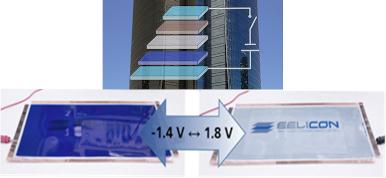
An Electrochromic Device (ECD) is designed for the control of optical properties through an electrical system. Transmissive ECDs can have a broad spectrum of applications, from smart windows to appliances, optical glasses, and automotive under the concept of energy savings. State of the art ECDs use as active materials inorganic oxides able to switch from a colored to a bleached state under a voltage stimulus. However, these materials are expensive, slow in switching between the optical states and required an integration in glasses.
The use of Electrochromic Conjugated (EC) polymers will open the doors to the production of low cost ECDs on flexible plastic supports, but EC generally lack a fully colorless bleached state. To overcome this drawback, we have designed of a new thiophene based polymer that can be deposited as thin‐film in a customized high‐throughput and large‐area roll‐to‐roll polymerization process. The new polymer provides enhanced electrochromic properties in terms of color contrast and neutrality. Indeed, the intense blue‐colored thin films exhibit high cycle stability (10000 cycles) and fast response times. Large area (up to A3 format), plastic, and flexible see‐through ECDs were fabricated out integrating the new polymer with suitable components, i.e. electrolytes and ion storage material. These results have been obtained in the frame of three EU funded projects, namely NANOEFFECTS, INNOSHADE, and EELICON.
Macher, S.; Schott M.; Sassi M.; Facchinetti I.; Ruffo R.; Patriarca G.; Beverina L.; Posset U.; Giffin G.A.; Loebmann P. New Roll‐to‐Roll Processable PEDOT‐Based Polymer with Colorless Bleached State for Flexible Electrochromic Devices. ADVANCED FUNCTIONAL MATERIALS 30(6), 1906254. (2020).
Quasi-thresholdless Photon Upconversion in Metal–Organic Framework Nanocrystals
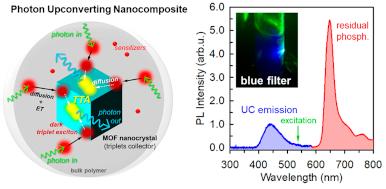
Photon upconversion based on sensitized triplet–triplet annihilation (sTTA) is a poweverfull strategy for the development of light-managing materials aimed to enhance the performance of solar devices by recovering unused low-energy photons. This work shows that the creation of triplet pairs in metal–organic framework nanocrystals (nMOFs) with size smaller than the exciton diffusion length implies a 100% TTA yield regardless of the illumination condition. This makes each nMOF a thresholdless, single-unit annihilator. A kinetic model of the upconversion dynamics in a nanocrystals ensemble reveals that, for materials based on such a thresholdless annihilator, the performances are limited only by the statistical distribution of the excitation energy among nanocrystals. The model is validated by fabricating a nanocomposite material based on nMOFs, which shows efficient upconversion under a few percent of solar irradiance, matching the requirements of real-world solar technologies.
Meinardi, F.; Ballabio, M.; Yanai, N.; Kimizuka, N.; Bianchi, A.; Mauri, M.; Simonutti, R.; Ronchi, A.; Campione, M.; Monguzzi, A. Quasi-thresholdless Photon Upconversion in Metal–Organic Framework Nanocrystals. NANO LETTERS 19, 2169 (2019).
Tight Xenon Confinement in a Crystalline Sandwich-like Hydrogen Bonded Dimeric Capsule of a Cyclic Peptide
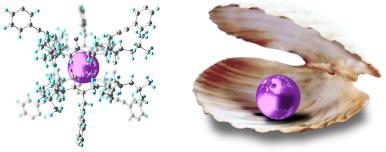
We demonstrate that a cyclic hexapeptide self-assembles and forms a dimeric capsule, which tightly encapsulates a single xenon atom, like a pearl in its shell. The obtained molecular crystals of peptide dimers with encapsulated xenon can be manipulated in the open air at room temperature, with no gas release. Xenon receives the anisotropic imprint of the clamping dimers, as perceived by 129Xe NMR spectroscopy. The consequence of the present design is to provide a tool to construct supramolecular structures, based on biological building blocks, capable of capturing selectively rare gases, which find important applications in lighting, medical imaging, sensing and neuro-protection.
Pizzi, A.; Ozores, H.L.; Amorin, M.; Demistri, N.; Terraneo, G.; Bracco, S.; Comotti, A.; Sozzani, P.; Bezuidenhout, C. X.; Metrangolo, P.; Granja, J.R. Tight Xenon Confinement in a Crystalline Sandwich-like Hydrogen Bonded Dimeric Capsule of a Cyclic Peptide. ANGEWANDTE CHEMIE INTERNATIONAL EDITION 131, 14614. (2019).
Droplet epitaxy of semiconductor nanostructures for quantum photonic devices
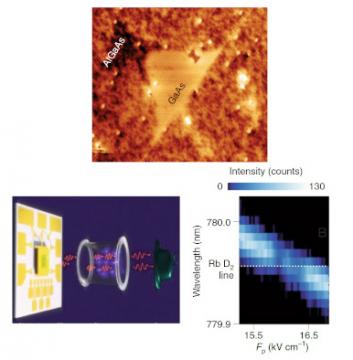
The long dreamed ‘quantum internet’ would consist of a network of quantum nodes (solid-state or atomic systems) linked by flying qubits, naturally based on photons, travelling over long distances at the speed of light, with negligible decoherence. A key component is a light source, able to provide single or entangled photon pairs. Among the different platforms, semiconductor quantum dots (QDs) are very attractive, as they can be integrated with other photonic and electronic components in miniaturized chips. Because of their robustness and simplicity QDs became the workhorse of quantum photonics permitting to achieve several breakthroughs in both fundamental and technological areas. The need for specific emission wavelengths or structural and optical properties has motivated further research on routes to obtain high-quality semiconductor nanostructures. The recent reports on the generation of highly entangled photon pairs, combined with good photon indistinguishability, show that droplet epitaxy outperforms conventional QDs obtained via Stranski–Krastanov growth mode as quantum emitters.
Gurioli, M., Wang, Z., Rastelli, A., Kuroda, T., Sanguinetti, S. Droplet epitaxy of semiconductor nanostructures for quantum photonic devices. NATURE MATERIALS 18, 799 (2019).
Understanding the Influence of Cation Doping on the Surface Chemistry of NaTaO3 from First Principles
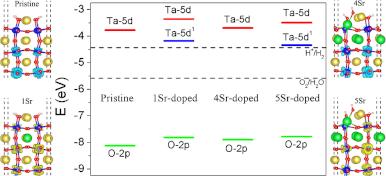
Sodium tantalate, NaTaO3, is one of the few photocatalysts capable to perform overall water splitting, i.e. simultaneously produce O2 and H2 from water. In particular, an interesting and not fully understood observation is that the efficiency of NaTaO3 increases dramatically in the presence of cation doping. To obtain better insight into the origin of this effect, we use first-principles calculations to investigate the fundamental structural, electronical, and chemical properties of pristine and Sr-doped NaTaO3. Our results show that Sr donor−acceptor codoping at Na and Ta sites significantly reduces the formation energy of the Sr dopants. Further study of the energetics of the oxygen evolution reaction (OER) shows a substantial reduction of its overpotential for the codoped material, consistent with recent suggestions that codoping is crucial for increasing NaTaO3’s efficiency. The detailed insights provided by our work could benefit the design and preparation of new efficient catalysts based on NaTaO3.
Tang, Z.-K.; Di Valentin, C.; Zhao, X.; Liu, L.-M.; Selloni, A. Understanding the Influence of Cation Doping on the Surface Chemistry of NaTaO3 from First Principles. ACS CATALYSIS 9, 10528. (2019).
Engineering Porous Emitting Framework Nanoparticles with Integrated Sensitizers for Low Power Photon Up-conversion by Triplet Fusion
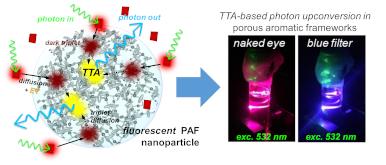
The conversion of low-energy light into photons of higher energy based on sensitized triplet–triplet annihilation (TTA) upconversion is the most promising wavelength-shifting methodology because it operates efficiently at excitation powers as low as the solar irradiance. The production of solid-state upconverters suited for direct integration in devices is solved here by fabricating porous fluorescent nanoparticles wherein the emitters are integrated into robust covalent architectures. These emitting porous aromatic framework (ePAF) nanoparticles allow intimate interaction with the included metallo-porphyrin as triplet sensitizers. The high concentration of framed chromophores ensures hopping-mediated triplet diffusion required for TTA, yet the low density of the framework promotes their high optical features without quenching effects, typical of the solid state. A green-to-blue photon upconversion yield as high as 15% is achieved: a record performance among annihilators in a condensed phase. Furthermore, the engineered ePAF architecture containing covalently linked sensitizers produces full-fledge solid-state bicomponent particles that behave as autonomous nanodevices.
Perego, J.; Pedrini, J.; Bezuidenhout, C. X.; Sozzani, P. E.; Meinardi, F.; Bracco, S.; Comotti, A.; Monguzzi, A. Engineering Porous Emitting Framework Nanoparticles with Integrated Sensitizers for Low Power Photon Up-conversion by Triplet Fusion. ADVANCED MATERIALS 31 (40), 1903309 (2019).
Structural evolution of atomically dispersed Pt catalysts dictates reactivity
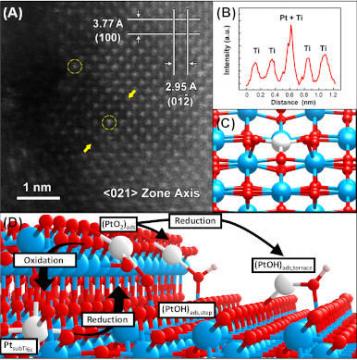
The use of oxide-supported isolated Pt-group metal atoms as catalytic active sites is of interest due to their unique reactivity and efficient metal utilization. However, relationships between the structure of these active sites, their dynamic response to environments and catalytic functionality have proved difficult to experimentally establish. Here, sinter-resistant catalysts where Pt was deposited uniformly as isolated atoms in well-defined locations on anatase TiO2 nanoparticle supports were used to develop such relationships. Through a combination of in situ atomic-resolution microscopy- and spectroscopy-based characterization supported by first-principles calculations it was demonstrated that isolated Pt species can adopt a range of local coordination environments and oxidation states, which evolve in response to varied environmental conditions. The variation in local coordination showed a strong influence on the chemical reactivity and could be exploited to control the catalytic performance.
De Rita, L; Resasco, J; Dai, S; Boubnov, A; Thang, H. V.; Hoffman, A. S.; Ro, I; Graham, G. W.; Bare, S. R.; Pacchioni, G.; Pan, X.; Christopher, P.Structural evolution of atomically dispersed Pt catalysts dictates reactivity. NATURE MATERIALS 18, 746-751 (2019).
Emissive Bi-Doped Double Perovskite Cs2Ag1−xNaxInCl6 Nanocrystals
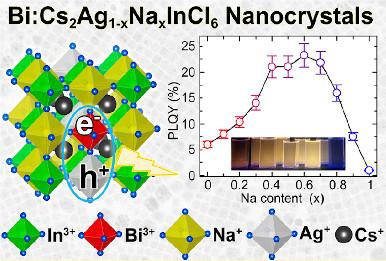
Double perovskites, also termed elpasolites, have gained increasing attention as heavy-metal-free alternatives to lead halide perovskite materials for applications spanning from photovoltaics to artificial lighting and solar concentration. Such an environmentally friendly composition, however, comes with a cost in terms of a low emission performance due to the disadvantageous electronic structure of elpasolites. As a result, the excitonic photophysics of this material system is much more complex than lead halide perovskites. This calls for specific multidisciplinary investigations to trace rational guidelines for their optimization and, ultimately, device application. This work reports the composition-dependent optical properties of Bi-doped Cs2Ag1−xNaxInCl6 nanocrystals having a double perovskite crystal structure. Spectroscopic investigations corroborated by density functional theory calculations revealed that the PL emission stems from trapped excitons between states localized in the BiCl6 and AgCl6 octahedra, respectively. Our findings indicated that both the partial replacement of Ag+ with Na+ ions and doping with Bi3+ cations are essential in order to optimize the PL emission of these systems.
Locardi, F.; Sartori, E.; Buha, J.; Zito, J.; Prato, M.; Pinchetti, V.; Zaffalon, M.L.; Ferretti, M.; Brovelli, S.; Infante, I.; De Trizio, L.; Manna, L. Emissive Bi-Doped Double Perovskite Cs2Ag1−xNaxInCl6 Nanocrystals. ACS ENERGY LETTERS 4, 1976−1982 (2019).
Interplay between Structural and Thermoelectric Properties in Epitaxial Sb2+xTe3 Alloys
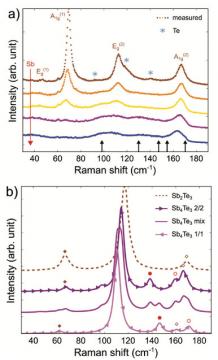
Antimony telluride alloys are of interest for applications in thermoelectric devices and in phase-change non-volatile electronic memories. Here, we report on the structural and thermoelectric properties of epitaxial Sb2+xTe3 films grown by Molecular Beam Epitaxy. A combination of x-ray diffraction and Raman spectroscopy, aided by theoretical modeling based on electronic structure calculations, allowed unveiling the crystal structure of these layered alloys and its dependence on composition. The presence of both Sb2 and Sb4 blocks and a link between structural disorder and thermoelectric performances have been highlighted.
Cecchi, S; Dragoni, D; Kriegner, D; Tisbi, E; Zallo, E; Arciprete, F; Holý, V; Bernasconi, M; Calarco, F. Interplay between Structural and Thermoelectric Properties in Epitaxial Sb2+xTe3 Alloys. ADVANCED FUNCTIONAL MATERIALS 29, 1805184 (2019).